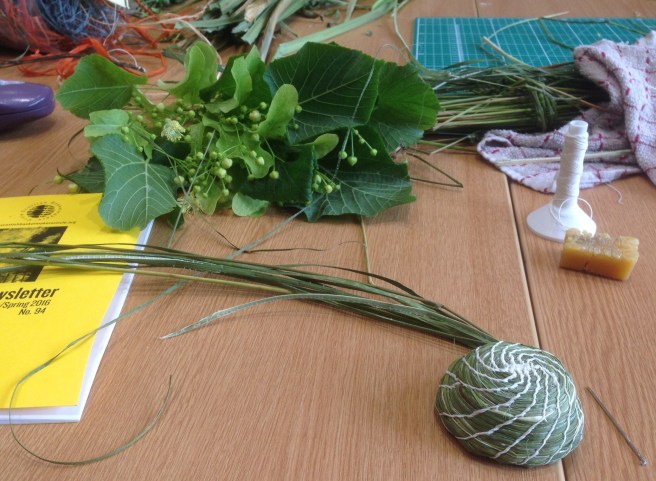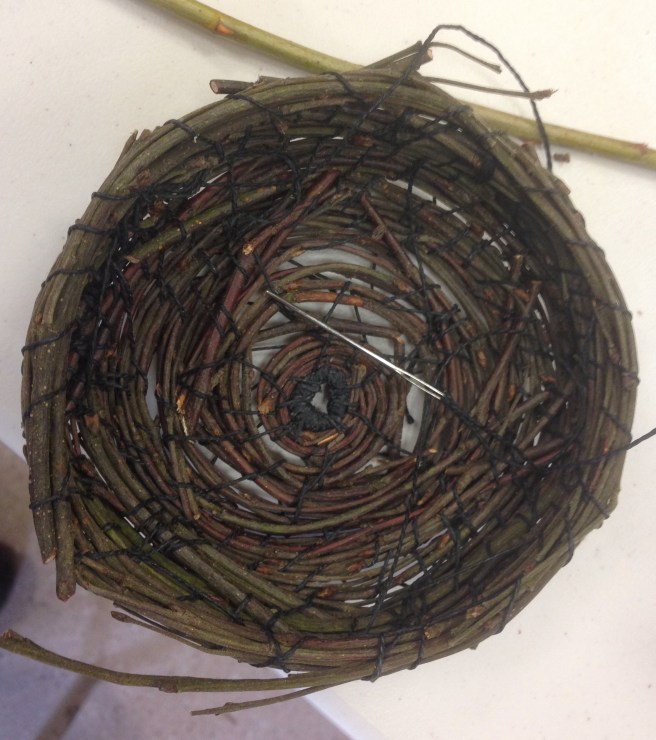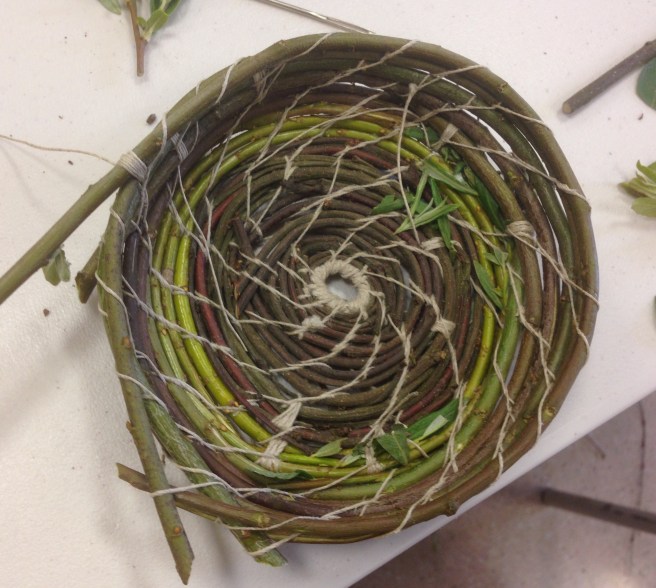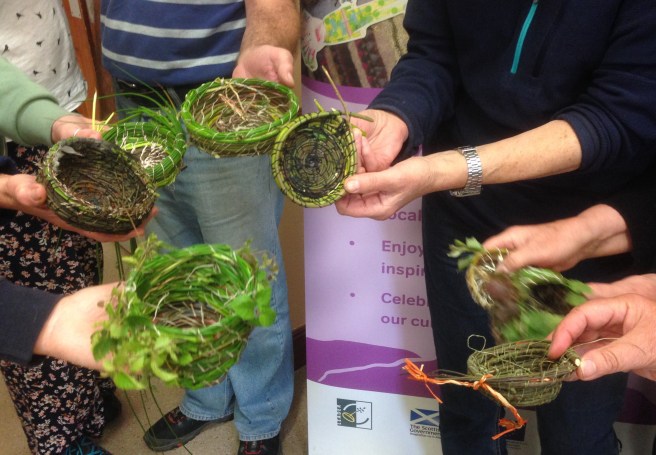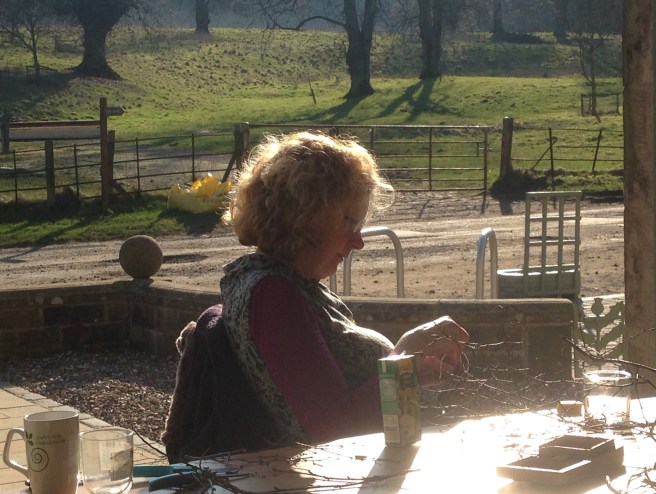baskets
New year, new work

Time to start a new project. I’m taking part in North Fife Open Studios this year, doing a ‘mini-residency’ at the Centre for Stewardship Falkland over the weekend of 29th April to 1st May. I’ve decided to create a new piece of work for the event, a multiple, composed of stitched baskets and pods; two for each species of tree I find on Falkland Estate between now and the end of April.
I’ll name the work for the number of species I find. I’m hoping for more than ’28 Trees’. That’s the number I came up with while trying to get to sleep one night after Christmas. I started with native species – oak, birch, alder, elm – and worked my way through to the exotics: horse chestnut, Norway spruce, redwood, sycamore. Some of these are old favourites, for example the birches and willows, I love working with them. They are very flexible, have interesting bark colours and sweet scents. Some trees will be more challenging, like the horse chestnut with its sturdy branches and sticky leaf-buds.
I’ll post progress reports on this blog. There is a self-imposed set of rules: baskets/pods to be roughly similar size and shape, same black thread to be used throughout, one handful of twigs to be used for each tree species: one larger basket/pod to be made first, one small one to be made from the remaining twigs. More about the reasons for that in a later post.
First two completed last week: oak. I think this is English oak, Quercus robur. That would fit with it growing in a hedge round an arable field in lowland Fife. I’m happy to be corrected on any of these twig identifications though!
Lipiec
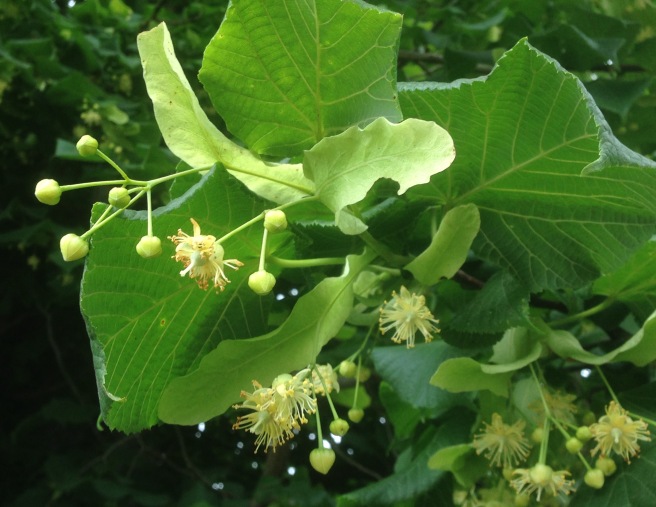
Today I took over the Craft Hub at the Centre for Stewardship for a ‘mini-residency’, a whole day to make whatever I wanted while chatting to visitors. I decided what I was going to make on my way in from the car park. The lime trees were covered in blossom and buzzing with bees. They reminded me of an experiment I’d been wanting to do for a while – to make a bee skep, an old-fashioned beehive.
Cultures all over the world have designed homes and shelters for honeybees for thousands of years. The little domed hives made from straw have become familiar as a symbol for honey and hard work, appearing on stamps, labels and logos.

In the mid-1990’s I worked as a ceramic painter for the Griselda Hill Pottery in Ceres and was trained to paint many traditional Wemyssware designs. I loved the beehive design. At its centre is a straw skep on its table, surrounded by long grass and birch trees. A random number of bees are painted flying round the hive. We would draw them lightly in pencil on the plate or pot then follow a set procedure for painting the bees – body, head, wings, legs, antennae, stripes. I had a special brush I kept for bee wings, it was old and worn and allowed me to paint each wing in one stroke of dilute brown. When done well, the wings looked smoky and transparent and the bees looked alive. More like bumblebees than honeybees, but definitely bees.

The hard-workers in the Falkland limes today were bumblebees. While trying to get a photograph of one bee I was immersed in a wonderful sweet scent. I looked for more information about lime trees when I got home and found out that the blossoms can be used to make a calming and reviving tea. I found this and much more fascinating lime tree information on a good blog post: https://gerryco23.wordpress.com/2011/08/03/the-intoxicating-scent-of-lime-trees/

There is a little bee skep in the Fife Folk Museum in Ceres, on a high shelf on the way to the toilets. It is made of straw and cane, and decorated with hand-made bees! The label says “Handmade by Police Sergeant Harry Strathie of Dairsie on his retiral in 1980s. Donor: Miss Provan, Dura Den”. I’d love to know more.

There were plenty of reedmace leaves and soft rushes left from last week’s Summer Baskets workshop, a suitable substitute for straw for my mini-skep prototype. Linen thread, beeswax and blunt needle for stitching as usual. My aim was to reproduce the skep shape using the stitching method I’ve been teaching in workshops, to see if it would work and look at all skep-like.
Marek came in to see me at this point and stayed for a while to talk about all things basket. He took part in one of my workshops last year and since then has taken his researches much further than me. He showed me photos on his phone of woven baskets he has made recently using spruce roots. They are very beautiful, I hope he chooses to exhibit them at the Centre in future.
We also talked about trees, lime in particular. Marek told me that in Poland this month is named after the lime tree. ‘July’ is ‘Lipiec’, named for the month when the lime trees blossom.
Back to work on the mini-skep. At this point it was difficult to stop the coils from turning in, making the base narrower than the sides. I wanted a more conical shape, like the Fife Folk Museum skep. I unpicked three or four coils here and re-stitched them but I couldn’t persuade the materials to open out any further, so went with vertical sides.
It is difficult to see in the old illustrations how the bee hole is made. This method might be a bit coarse but I think it would work well enough at a larger scale too. When I looked up skeps on the internet this evening, I was amazed at how many shapes and sizes have been used in the past. Cones, cylinders, bells, balls, holes at the base or half way up, made of straw, grass, willow, stitched with cane or split brambles, some even coated with mud. Room for further experiment and on a larger scale…
Basket catch-up
Two basket workshops over the last couple of weeks, both very interesting. The first one was for a team from Scottish Natural Heritage at the Centre for Stewardship, Falkland. This was the biggest and fastest basket workshop I’ve ever run! The second was for a smaller group in the fantastic Portmoak Village Hall in Kinross-shire.
The SNH group had meetings and presentations in the morning and a choice of activities for the afternoon. The weather was dreich, the Big Dig on the Estate was rained off so I accepted a group of 20 for ‘Fast Baskets’, a two-hour introductory session of birch coiling and stitching. The atmosphere was relaxed, the concentration was intense, the results were very impressive…
I had prepared and tied bundles of birch twigs to speed up the materials selection process, knowing we would be short of time. I liked the creative use of the raffia binding in this piece.
Lovely use of beachcombed polyprop rope for extra texture and colour.
Alternative function for a tiny basket!
……………………………………………
The Portmoak basket workshop was funded by the Living Lomonds Landscape Partnership for the Portmoak Community Woodland team. They have been doing great work since the mid-1990s on Portmoak Moss, restoring the rare raised bog and surrounding woodland. More info about that on their excellent website: http://www.portmoakcw.org.uk
With permission (of course), I visited the Moss to collect materials to supplement my store of birch twiggage weeded out of the Lochore Meadows Country Park coppice woodland. Portmoak Moss is another undiscovered treasure close to home, I’m very glad this workshop gave me the incentive to explore it. It’s a surreal place. To get onto the Moss you have to climb a well-built flight of steps, taking you up a vertical face of dark dripping peat. At the top you look out over a landscape of grasses, rushes and mosses that could be Highland peat bog – with Bishop Hill in the background to remind you that you’re still in the Lowlands.
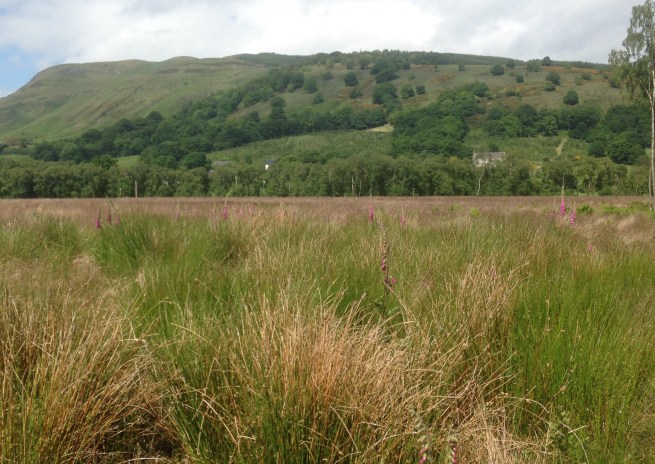
Can you see the deer in this photograph? I was bent over collecting willow twigs when I felt as if I was being watched. I looked up to see a deer looking at me.

It came closer and stopped. I stood still, phone ready to take a photo.
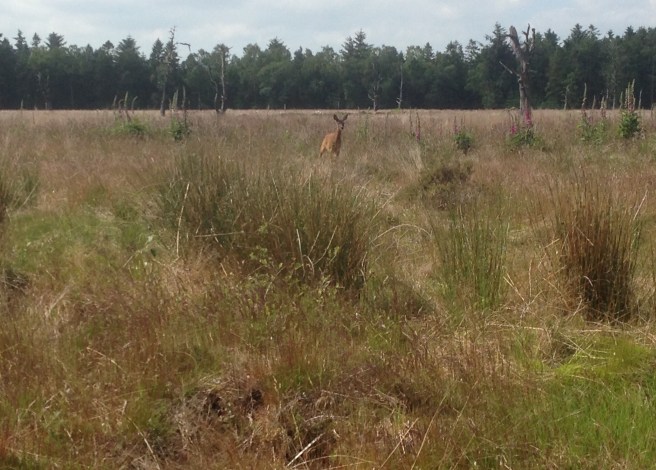
It looked straight at me, sniffed the air and came a bit closer

I don’t know if it identified me at that point but it moved off slowly to the north, grazing as it went

I think it must have caught my scent eventually. It barked and started to run further onto the bog, then stopped again to graze! Very relaxed. Is it used to seeing kind conservationists with well-controlled dogs? Or is it ill? I thought it looked a bit thin, especially around its back-end. Perhaps an elderly roe deer with poor eyesight and failing sense of smell? It ran fast enough though when it decided to go.
Back to the workshop. The materials I collected from the Moss were mostly young trees self-seeded into the peat. Removing these is an on-going battle for the Community Woodland team (hint of irony there), so my plan with the basket workshop was to offer a creative use for the little trees and their roots. It was a bit weird to be pulling up and cutting small native trees, but I looked out over the Moss with its bog cottons and red sphagnums and appreciated the need for tree control. I reassured myself with the thought “all conservation practice is a choice anyway, nowhere is ‘natural’…”
Spring baskets
First warm weekend of Spring, first basket workshop taught outdoors (well, with doors open anyway) and first time working in the new Craft Hub at the Centre for Stewardship, Falkland. It was a good day with a lovely bunch of people.
We used twigs I’d collected from the roadside and path edges in Falkland Estate, a selection of birch, willow, larch, alder, hawthorn (thorns removed), lime, an accidental piece of honeysuckle and a few pussy willows.
We opened the glass doors and worked half-in, half-out of the room. Very pleasant.
This workshop was supported by the Living Lomonds Landscape Partnership.
…………………………………
I’m running more creative events at the Centre for Stewardship, Falkland during the spring and summer.
The Craft Hub will be open over the Fife Open Studios weekend (7,8,9th May), drop in and say hello if you are in the area. I’ll be working away on baskets, rag-rug projects and demonstrating drop-spindle spinning.
There are plenty more full-day creative workshops in the programme. I’m running:
Paint and Draw like a Pict (Sat 28th May), a chance to learn more about Pictish art and try painting with natural ochre pigments collected in Fife.
Summer Baskets (Sun 10th July). We’ll be using grasses, rushes and other seasonal local materials for this one.
All materials provided, no experience needed, free, bookable through Eventbrite. See the events page on the Living Lomonds website for more details: http://www.livinglomonds.org.uk/events/



